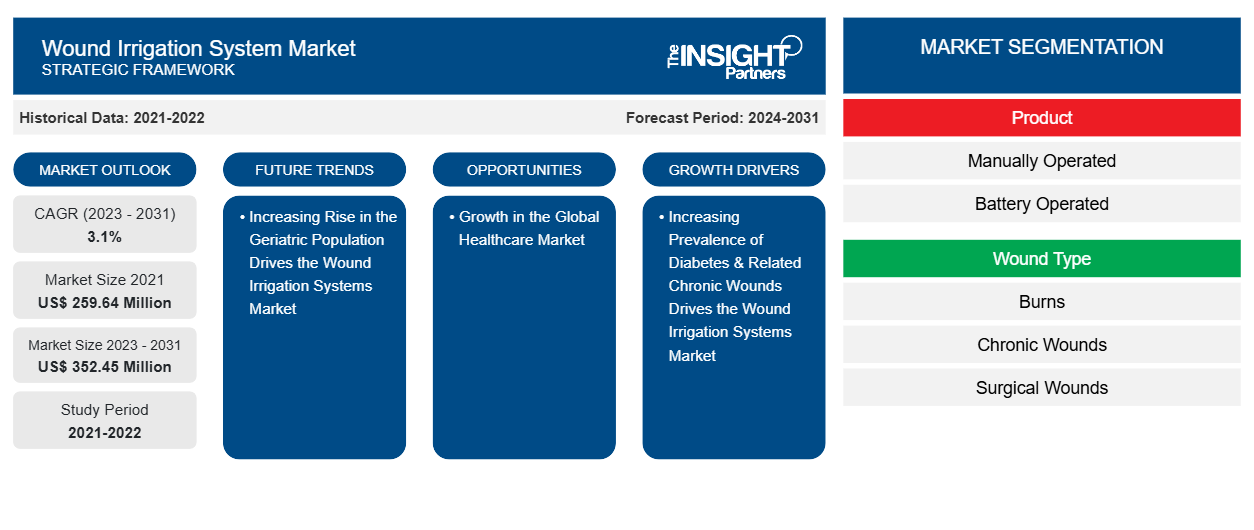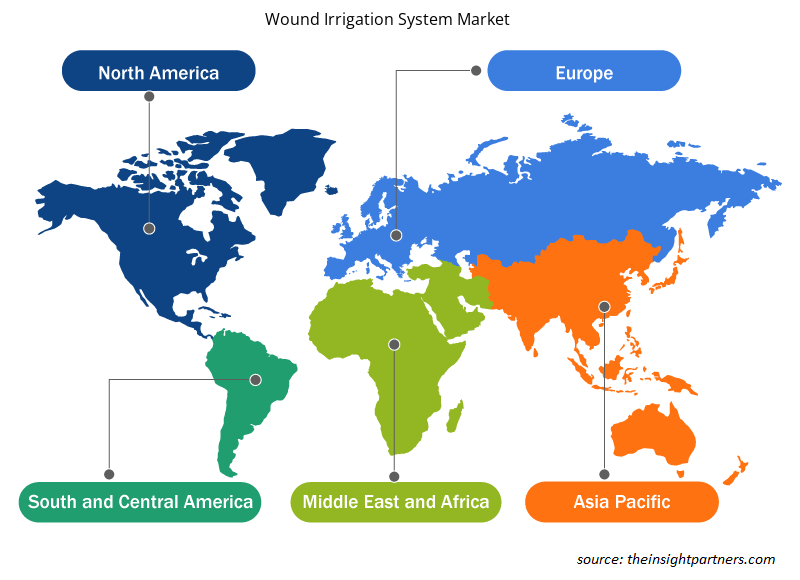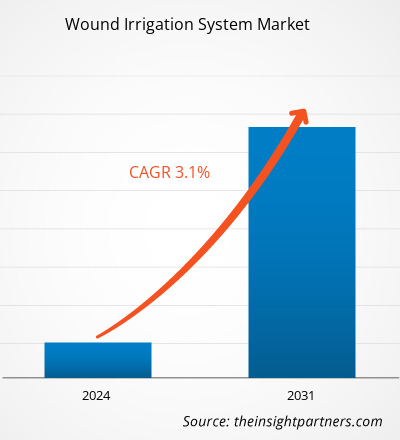The wound irrigation system market size was estimated to be US$ 259.64 million in 2021 and US$ XX million in 2023 and is expected to reach US$ 352.45 million by 2031; it is estimated to record a CAGR of 3.1% till 2031. Product innovations are likely to remain key trends in the market.
Wound Irrigation System Market Analysis
Global increase in chronic diseases such as autoimmune disorders, diabetes, and cancer is burdening healthcare systems worldwide. Chronic diseases directly impact the human body's natural ability to heal. Immunodeficiency conditions and diabetes are among the most harmful conditions that can slow wound repair. Diabetes is the commonly identified chronic disease associated with hospital-acquired and facility pressure injuries. It impacts the immune system, making infections more common and complicating wound healing. As per the International Diabetes Federation (IDF), the total number of people living with diabetes is anticipated to increase to 643 million by 2030 and 783 million by 2045. Therefore, the prolonged healing process due to chronic diseases leads to a long-term requirement for wound care, resulting in high demand of wound irrigation system propelling the wound irrigation system market growth.
Wound Irrigation System Market Overview
Global wound irrigation systems market is segmented by region into Asia Pacific, North America, Europe, Middle East & Africa, and South & Central America. According to the World Health Organization (WHO), approximately 1.3 million people die in road traffic crashes every year. Furthermore, between 20 and 50 million people suffer non-fatal injuries, with many experiencing disabilities due to their injuries. Thus, the growing number of road accidents is leading to an increased use of wound irrigation systems as it is an essential element of standard wound care.
Customize This Report To Suit Your Requirement
You will get customization on any report - free of charge - including parts of this report, or country-level analysis, Excel Data pack, as well as avail great offers and discounts for start-ups & universities
Wound Irrigation System Market: Strategic Insights

- Get Top Key Market Trends of this report.This FREE sample will include data analysis, ranging from market trends to estimates and forecasts.
Customize This Report To Suit Your Requirement
You will get customization on any report - free of charge - including parts of this report, or country-level analysis, Excel Data pack, as well as avail great offers and discounts for start-ups & universities
Wound Irrigation System Market: Strategic Insights

- Get Top Key Market Trends of this report.This FREE sample will include data analysis, ranging from market trends to estimates and forecasts.
Wound Irrigation System Market Drivers and Opportunities
Increasing Rise in the Geriatric Population to Favor Market
An elderly population is a group of people aged 65 and over. According to data provided by the United Nations, in 2017, the community that is 60 years and above is growing at a rate of about 3 percent annually. Worldwide, the number of individuals above 80 years of age is expected to triple by 2050. The aged population was almost 137 million in 2017, which will reach up to 425 million in 2050.
The aging population is more likely to have chronic wounds than the young population, and the effect of chronic wounds on life quality is particularly severe in this population. The process of wound healing is extended in the aging population, due to the basic biology underlying chronic wounds and the influence of age-related changes on wound healing with an increase in the number of geriatric populations. The prevalence of chronic diseases and related injuries has increased. Therefore, the demand for wound irrigation systems is expected to increase in the coming years.
Growth in the Global Healthcare Market
The healthcare industry has been experiencing rapid transformations in recent years, with various technological advancements being witnessed. Technology-enabled care (TEC) solutions are being preferred in healthcare systems in emerging economies to meet the growing demand for better healthcare facilities. Growing incidence of chronic illnesses, rising aging population, and increase in the need for pediatric care are the major factors driving the growth of the healthcare sector.
A number of established market players have been investing a significant amount of their revenue in research and development activities to develop better and more advanced products and technologies for use in the healthcare industry. Additionally, the availability of reimbursement for various medical procedures is expected to fuel the industry's growth in the coming years.
The presence of regulations laid down by government bodies makes it possible to obtain better and more reliable healthcare facilities, ensuring quality care and patient safety while mitigating fraud and cyber threats.
There has been a significant increase in healthcare expenditure in recent years. According to the latest estimates of the Organization for Economic Cooperation and Development (OECD) Health Statistics 2023 database, the average health expenditure to GDP ratio for OECD countries decreased from 9.7% at the peak of the pandemic in 2021 to 9.2% in 2022. This ratio is still higher than the pre-pandemic level of 8.8%, although in 11 OECD countries, the ratio in 2022 is projected to have fallen below the 2019 pre-pandemic levels. When looking at country-level data, the USA had the highest health expenditure to GDP ratio at 16.6% in 2022, followed by France at 12.1% and Germany at 12.7%. The factors mentioned above are projected to offer wide growth opportunities in the wound irrigation system market.
Wound Irrigation System Market Report Segmentation Analysis
Key segments that contributed to the derivation of the wound irrigation system market analysis are product, wound type, and end user.
- Based on the product, the wound irrigation system market is bifurcated into manually operated and battery operated. The battery segment held a larger market share in 2023.
- By wound type, the market is segmented into burns, chronic wounds, surgical wounds, traumatic wounds, and others. The segment of chronic wounds held the largest share of the market in 2023.
- In terms of end users, the wound irrigation system market is segmented into ambulatory care centers, hospitals, and others. The hospitals segment held a significant share of the market in 2023.
Wound Irrigation System Market Share Analysis by Geography
The geographic scope of the wound irrigation system market report is primarily divided into five regions: Europe, North America, Asia Pacific, Middle East & Africa, and South & Central America.
North America has dominated the market. In US rates of chronic injuries among older people in the country are significantly high in the country. As per data published by Wound Healing Society, In the US, 3% of the population that is aged 65 years and above have open wounds. Hence, the factors as mentioned above, are anticipated to fuel the growth of North America wound irrigation systems market during the forecast period.
Wound Irrigation System Market Regional Insights
The regional trends and factors influencing the Wound Irrigation System Market throughout the forecast period have been thoroughly explained by the analysts at Insight Partners. This section also discusses Wound Irrigation System Market segments and geography across North America, Europe, Asia Pacific, Middle East and Africa, and South and Central America.

- Get the Regional Specific Data for Wound Irrigation System Market
Wound Irrigation System Market Report Scope
| Report Attribute | Details |
|---|---|
| Market size in 2021 | US$ 259.64 Million |
| Market Size by 2031 | US$ 352.45 Million |
| Global CAGR (2023 - 2031) | 3.1% |
| Historical Data | 2021-2022 |
| Forecast period | 2024-2031 |
| Segments Covered |
By Product
|
| Regions and Countries Covered | North America
|
| Market leaders and key company profiles |
Wound Irrigation System Market Players Density: Understanding Its Impact on Business Dynamics
The Wound Irrigation System Market market is growing rapidly, driven by increasing end-user demand due to factors such as evolving consumer preferences, technological advancements, and greater awareness of the product's benefits. As demand rises, businesses are expanding their offerings, innovating to meet consumer needs, and capitalizing on emerging trends, which further fuels market growth.
Market players density refers to the distribution of firms or companies operating within a particular market or industry. It indicates how many competitors (market players) are present in a given market space relative to its size or total market value.
Major Companies operating in the Wound Irrigation System Market are:
- Zimmer Biomet
- BSN Medical
- C.R.Bard (BD)
- CooperSurgical, Inc.
- Stryker
- Centurion Medical Products
Disclaimer: The companies listed above are not ranked in any particular order.

- Get the Wound Irrigation System Market top key players overview
Wound Irrigation System Market News and Recent Developments
The wound irrigation system market is evaluated by gathering qualitative and quantitative data post primary and secondary research, which includes association data, important corporate publications, and databases. A few of the developments in the wound irrigation system market are listed below:
- In April 2022, Sanara MedTech Inc., a provider of products and technologies for surgical and chronic wound care dedicated to improving patient outcomes, announced the completion of the previously announced merger to acquire Precision Healing Inc. (Source: Sanara MedTech Inc. Press Release, April 2022)
- In June 2021, Irrimax Corporation, the manufacturer of Irrisept, announced new clearance from the U.S. Food and Drug Administration (FDA), making Irrisept the only self-contained irrigation system for antimicrobial wound lavage in the US market. Currently, over 2,000 US hospitals are using the Irrisept, totaling more than 2 million lifetime uses. (Source: Irrimax Corporation, Newsletter, June 2021)
Wound Irrigation System Market Report Coverage and Deliverables
The “Wound Irrigation System Market Size and Forecast (2021–2031)” report provides a detailed analysis of the market covering below areas:
- Wound irrigation system market size and forecast at global, regional, and country levels for all the key market segments covered under the scope
- Wound irrigation system market trends as well as market dynamics such as drivers, restraints, and key opportunities
- Detailed SWOT analysis and PEST/Porter’s Five Forces
- Wound irrigation system market analysis covering key market trends, global and regional framework, regulations, major players, and recent market developments
- Industry landscape and competition analysis covering market concentration, heat map analysis, prominent players, and recent developments for the wound irrigation system market
- Detailed company profiles.
Frequently Asked Questions
Which region dominated the wound irrigation system market in 2023?
The North America region held the largest share of in the wound irrigation system market 2023.
What are the driving factors impacting the wound irrigation system market?
Factors such as increasing prevalence of diabetes & related chronic wounds and increasing rise in the geriatric population propel the wound irrigation system market.
What are the future trends of the wound irrigation system market?
Product innovations be the trend in the wound irrigation system market
Which are the leading players operating in the wound irrigation system market?
The wound irrigation system market majorly consists of the players, including Zimmer Biomet, BSN Medical and C.R.Bard (BD), CooperSurgical, Inc. Stryker, Centurion Medical Products, Sunmed, PulseCare Medical, Bionix Development Corporation, Westmed, Inc., and PulseCare Medical, LLC.
What would be the estimated value of the wound irrigation system market by 2031?
The wound irrigation system market is expected to be valued at US$ 352.45 million in 2030.
What is the expected CAGR of the wound irrigation system market?
The wound irrigation system market is estimated to record a CAGR of 3.1% till 2031.
- Historical Analysis (2 Years), Base Year, Forecast (7 Years) with CAGR
- PEST and SWOT Analysis
- Market Size Value / Volume - Global, Regional, Country
- Industry and Competitive Landscape
- Excel Dataset
Testimonials
Reason to Buy
- Informed Decision-Making
- Understanding Market Dynamics
- Competitive Analysis
- Identifying Emerging Markets
- Customer Insights
- Market Forecasts
- Risk Mitigation
- Boosting Operational Efficiency
- Strategic Planning
- Investment Justification
- Tracking Industry Innovations
- Aligning with Regulatory Trends
Yes! We provide a free sample of the report, which includes Report Scope (Table of Contents), report structure, and selected insights to help you assess the value of the full report. Please click on the "Download Sample" button or contact us to receive your copy.
Absolutely — analyst assistance is part of the package. You can connect with our analyst post-purchase to clarify report insights, methodology or discuss how the findings apply to your business needs.
Once your order is successfully placed, you will receive a confirmation email along with your invoice.
• For published reports: You’ll receive access to the report within 4–6 working hours via a secured email sent to your email.
• For upcoming reports: Your order will be recorded as a pre-booking. Our team will share the estimated release date and keep you informed of any updates. As soon as the report is published, it will be delivered to your registered email.
We offer customization options to align the report with your specific objectives. Whether you need deeper insights into a particular region, industry segment, competitor analysis, or data cut, our research team can tailor the report accordingly. Please share your requirements with us, and we’ll be happy to provide a customized proposal or scope.
The report is available in either PDF format or as an Excel dataset, depending on the license you choose.
The PDF version provides the full analysis and visuals in a ready-to-read format. The Excel dataset includes all underlying data tables for easy manipulation and further analysis.
Please review the license options at checkout or contact us to confirm which formats are included with your purchase.
Our payment process is fully secure and PCI-DSS compliant.
We use trusted and encrypted payment gateways to ensure that all transactions are protected with industry-standard SSL encryption. Your payment details are never stored on our servers and are handled securely by certified third-party processors.
You can make your purchase with confidence, knowing your personal and financial information is safe with us.
Yes, we do offer special pricing for bulk purchases.
If you're interested in purchasing multiple reports, we’re happy to provide a customized bundle offer or volume-based discount tailored to your needs. Please contact our sales team with the list of reports you’re considering, and we’ll share a personalized quote.
Yes, absolutely.
Our team is available to help you make an informed decision. Whether you have questions about the report’s scope, methodology, customization options, or which license suits you best, we’re here to assist. Please reach out to us at sales@theinsightpartners.com, and one of our representatives will get in touch promptly.
Yes, a billing invoice will be automatically generated and sent to your registered email upon successful completion of your purchase.
If you need the invoice in a specific format or require additional details (such as company name, GST, or VAT information), feel free to contact us, and we’ll be happy to assist.
Yes, certainly.
If you encounter any difficulties accessing or receiving your report, our support team is ready to assist you. Simply reach out to us via email or live chat with your order information, and we’ll ensure the issue is resolved quickly so you can access your report without interruption.





















 Get Free Sample For
Get Free Sample For